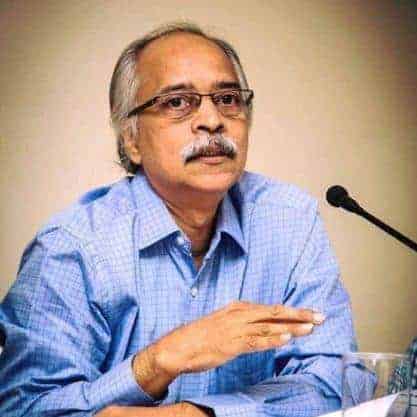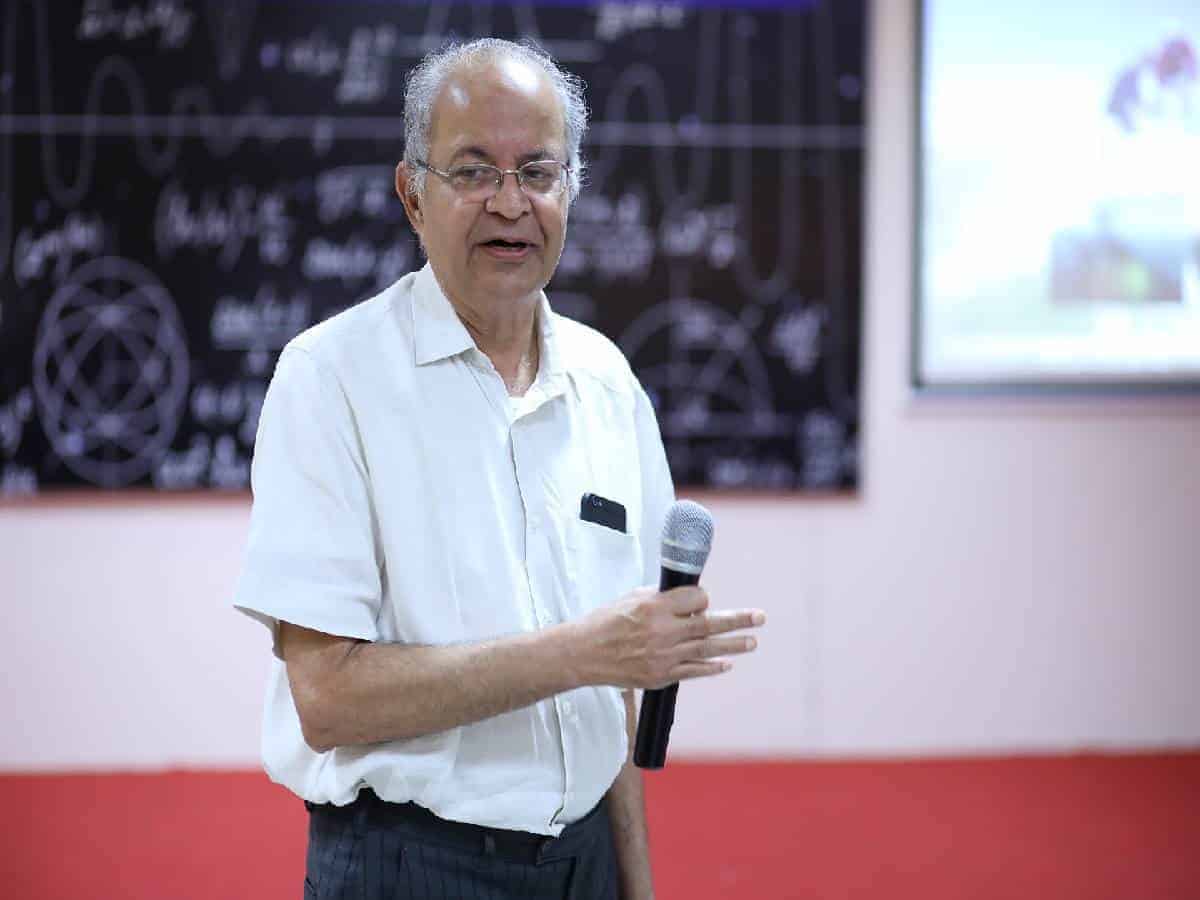
The Birla Planetarium and the Science Museum are part of the tourist circuit of Hyderabad for decades. Perched on a hillock, right in the heart of the city, one can take a seat and go on a quick and exciting trip into outer space through the shows that run at the Planetarium.
The man, who led teams that transformed the ‘Naubat Pahad’ into a modern science complex, attracting hundreds of common people to a good number of Nobel laureates and scientists over the last 35 years is Dr B G Sidharth.
Naubat Pahad ( Drum House Hill) or a small hillock rising about 300 feet was supposed to have been used by the erstwhile rulers of Hyderabad to make public announcements to its subjects by beating of drums to draw attention. There was also a garden and a square room in the form of a huge stool, according to historic accounts.
It was sometime during the Chief Ministership of Dr Marri Channa Reddy in the late 1970s that the Birlas through the efforts of Mr P Vaman Rao, former Information Commissioner of AP and their key representative and others got this scenically well located piece of land to develop their dream projects of a Science Centre and a marble temple. In the next decade, hectic activity ensued and both the marble temple on one hillock and the BM Birla Planetarium & Science Centre on another sprang up.
The B M Planetarium was inaugurated in 1985 by the then Chief Minister, N T Rama Rao. Dr Sidharth became the first Director. Thereafter, he led the growth and expansion of the Planetarium, Science Museum, Observatory, Astronomy Research Centre, Dinosaur museum etc. and organised a wide range of activities till April 2021, when he retired.
Confluence of Nobel Laureates, school children
The Planetarium started off with good advantages. It’s central and scenic location and good connectivity gave it a fillip. Also, helped were the factors such as Hyderabad being a Science City with many national institutes, universities and educational institutes. The reappearance of the Haley’s Comet (once 76 years) in 1986 and the Planetarium coming up with a timely show, gave it a further fillip.
The constant change in shows covering various aspects of space, stars, supernovas, planets and mysteries like the Black Holes and the exciting narration, made by Dr Sidharth and team slowly but surely attracted many people. The special shows for school children, getting onto the tourist circuit and initiatives to host workshops and training programmes made the Planetarium a go to place.
The small trek to the Planetarium, the lose yourself journey into the depths of Space for an hour, a walk through the exhibits, where one could get a comparative weight on another planet and finally enjoy the panoramic view of the city was a huge incentive for a visit through the 1980s and 1990s. Those were days of Cinema theatre, books, visits to historical places, physical lectures and learning. Internet, Google and the 21st century technology though have added a different dimension.
It was at the Planetarium that as an enthusiastic reporter, I had the privilege of hearing & meeting several Nobel laureates and top scientists. During the late 1980s, Fred Hoyle, the legendary Astronomer, Jayant Narlikar, India’s most reputed Astrophysicist and science populariser even now, Prof Satish Dhawan, former Chairman (1972-82), Indian Space Research Organisation (ISRO) to name a few were star visitors.
Incidentally in 1987, Sir Fred Hoyle, the astrophysicist who predicted origins of life from outer space to rejecting the popular Big Bang theory of the origin of the universe but never won the Nobel Prize delivered the B.M. Birla Memorial Lecture, FIFTY YEARS OF COSMOLOGY. Jayant Narlikar collaborated with Dr Hoyle in important theories.
In the decades of its growth, the Planetarium emerged, “Not only as one of the best attended Planetaria in the world, it has also been acclaimed to be amongst the very best with a better rating than those in Europe, the US, Far East, Soviet Republics and elsewhere,” according to the BM Birla Science Centre.
The Science Centre also saw a steady stream of nearly 30 Nobel laureates, including Dr Norman Borlaug, the agriculture scientist and father of ‘Green Revolution’, who delivered a lecture in 1996; Dr James Watson, co-discoverer of the Double Helix structure of DNA with Dr Francis Crick; a rare event of all the 3 laureates who shared the 1997 prize in Physics—Prof Steven Chu, Prof Claude Cohen Tannoudji and Dr William Daniel Philips, though in different years; Dr Venkatraman Ramakrishnan, Indian origin scientist who won the Chemistry Nobel delivered a lecture in 2013. The most recent visitor was Dr Sergie Haroche in 2016, a Nobel winner in Physics for 2012.
Research, controversy and contribution of Dr Sidharth
Dr Sidharth too made some remarkable contributions to astrophysics which earned him reputation and ability to draw great men of Science to the Centre and keep it bustling with research and popularisation activity. His work particularly in particle physics and cosmology has been often cited as far reaching in nature. In 1997, when the standard big bang model was the accepted theory, with the Universe believed to be slowing down to a half due to dark matter, Sidharth put forward his dark energy driven accelerating universe cosmology, with a small cosmological constant.
This contra prediction, which challenged the existing model was confirmed by observation the very next year. Today dark energy is the new paradigm and the 2011 Nobel Prize in Physics went to the Observational Evidence for all this, done in 1998. Dr Sidharth often expressed the view that his contribution should have been recognised by the Nobel Committee.
Commenting on this, a very reputed publication quoted Nobel Laureate Prof. Tony Leggett: “…It is of course clear that your equation predicts an exponential (inflation-type) expansion of the current universe, hence acceleration. And it would have been nice if the Nobel committee had mentioned this.”
Dark energy is an all pervading force that is different from the other known forces like electromagnetism. It relentlessly pushes the galaxies away, making them speed up in the process. This acceleration itself is small.
The Science Centre also undertook an EU project on Hydrology to study the groundwater, drinking water issues of Hyderabad with expertise and comparable models from France, Austria and Italy. The National Geophysical Research Institute (NGRI) and Jawaharlal Nehru Technological University (JNTU) also participated.
Over the years, Dr Sidharth played an active role in science popularisation too. He was pro-active in hosting science meets, organising popular lectures, summer workshops for budding astronomers and school children, associated with the AP Akademi of Sciences etc.
A high point in Dr Sidharth’s long career was being honoured with Italy’s highest civilian honour to a non Italian-Knight commander of the Order of the Star of Italian Solidarity. He also won the Institute for Theoretical Physics and Advanced Mathematics, Einstein-Galilei (IFM) award 2013. A Fellow of the Royal Astronomical Society he published 300 papers in international research journals in his four decades of research work.
The Space Museum and beyond
In 2019, the Science Centre added another feather to its cap, when the ISRO agreed to contribute to a Space Museum with a collection of 65 large sized models of various spacecraft, satellites and rockets up to Mangalyaan. The collaborative project occupies about 9000 sq ft in the existing Science Museum.
In the museum curated by Pranav Sharma, the young Scientific Officer at the Centre, the biggest is the giant GSLV Rocket which would be approximately 60 feet tall. Then there are the models of other rockets like the PSLV, a section on Remote Sensing images and also a special enclosure in which visitors can directly get in touch with India’s Antarctic Space Station (Dakshin Gangotri) in real time. The Space Museum was inaugurated by E.S.L. Narasimhan, Governor of Telangana on July 26, 2019 as part of the Golden Jubilee celebrations of the Trust, the Birla Archaeological and Cultural Research Institute.
Born in Visakhapatnam in July 1948 and obtaining a Master’s and doctorate from the Calcutta University, the 72-year-old Dr Sidharth continues his passion of working on astrophysics.
Somasekhar Mulugu, former Associate Editor & Chief of Bureau of The Hindu BusinessLine, is a well-known political, business and science writer and analyst based in Hyderabad

